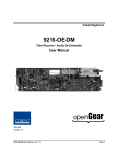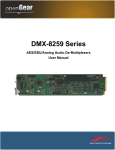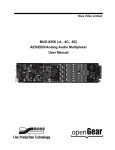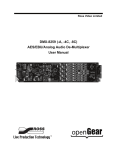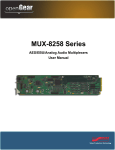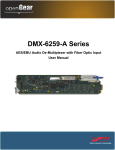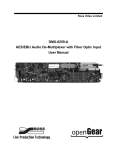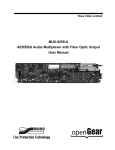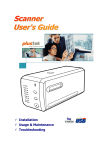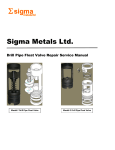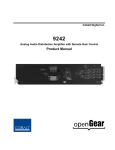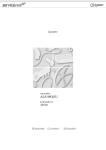Download 9275-4C / 9275-8C Product Manual
Transcript
Cobalt Digital Inc. 9275-4C 9275-8C HD/SD-SDI Analog Audio De-Embedders User Manual 9275-4C8C-OM Version: 1.2 9275-4C / 9275-8C User Manual • (V 1.2) Page i 9275-4C / 9275-8C • Analog Audio De-Embedder User Manual • • • • • Cobalt Digital Inc. Part Number: 9275-4C8C-OM Document Version: 1.2 Printed in the United States. Last Author: CGG Printing Date: 12/15/11 The information contained in this manual is subject to change without notice or obligation. Copyright © 2011 Cobalt Digital Inc.. All rights reserved. Contents of this publication may not be reproduced in any form without the written permission of Cobalt Digital Inc.. Reproduction or reverse engineering of copyrighted software is prohibited. Patents This product is protected by the following US Patents: 4,205,346; 5,115,314; 5,280,346; 5,561,404; 7,034,886; 7,508,455. This product is protected by the following Canadian Patents: 2039277; 1237518; 1127289. Other patents pending. Notice The material in this manual is furnished for informational use only. It is subject to change without notice and should not be construed as commitment by Cobalt Digital Inc.. Cobalt Digital Inc. assumes no responsibility or liability for errors or inaccuracies that may appear in this manual. Trademarks • • is a registered trademark of Ross Video Limited. is a registered trademark of Cobalt Digital Inc. All other product names and any registered and unregistered trademarks mentioned in this manual are used for identification purposes only and remain the exclusive property of their respective owners Page ii 9275-4C / 9275-8C User Manual • (V 1.2) Important Regulatory and Safety Notices Before using this product and any associated equipment, refer to the “Important Safety Instructions” listed below to avoid personnel injury and to prevent product damage. Products may require specific equipment, and/or installation procedures to be carried out to satisfy certain regulatory compliance requirements. Notices have been included in this publication to call attention to these specific requirements. Symbol Meanings This symbol on the equipment refers you to important operating and maintenance (servicing) instructions within the Product Manual Documentation. Failure to heed this information may present a major risk of damage or injury to persons or equipment. Warning — The symbol with the word “Warning” within the equipment manual indicates a potentially hazardous situation which, if not avoided, could result in death or serious injury. Caution — The symbol with the word “Caution” within the equipment manual indicates a potentially hazardous situation which, if not avoided, may result in minor or moderate injury. It may also be used to alert against unsafe practices. Notice — The symbol with the word “Notice” within the equipment manual indicates a situation, which if not avoided, may result in major or minor equipment damage or a situation which could place the equipment in a non-compliant operating state. ESD Susceptibility — This symbol is used to alert the user that an electrical or electronic device or assembly is susceptible to damage from an ESD event. Important Safety Instructions Caution — This product is intended to be a component product of the 8300 series frame. Refer to the 8300 series frame User Manual for important safety instructions regarding the proper installation and safe operation of the frame as well as its component products. Warning — Certain parts of this equipment namely the power supply area still present a safety hazard, with the power switch in the OFF position. To avoid electrical shock, disconnect all AC power cards from the chassis’ rear appliance connectors before servicing this area. 9275-4C / 9275-8C User Manual • (V 1.2) Page iii Warning — Service barriers within this product are intended to protect the operator and service personnel from hazardous voltages. For continued safety, replace all barriers after any servicing. This product contains safety critical parts, which if incorrectly replaced may present a risk of fire or electrical shock. Components contained with the product’s power supplies and power supply area, are not intended to be customer serviced and should be returned to the factory for repair. To reduce the risk of fire, replacement fuses must be the same time and rating. Only use attachments/accessories specified by the manufacturer. Warning —This product includes an “Ethernet Port” which allows this product to be connected to a local area network (LAN). Only connect to networks that remain inside the building. Do not connect to networks that go outside the building. EMC Notices United States of America FCC Part 15 This equipment has been tested and found to comply with the limits for a class A Digital device, pursuant to part 15 of the FCC Rules. These limits are designed to provide reasonable protection against harmful interference when the equipment is operated in a commercial environment. This equipment generates, uses, and can radiate radio frequency energy and, if not installed and used in accordance with the instruction manual, may cause harmful interference to radio communications. Operation of this equipment in a residential area is likely to cause harmful interference in which case the user will be required to correct the interference at his own expense. Notice — Changes or modifications to this equipment not expressly approved by Cobalt Digital Inc. could void the user’s authority to operate this equipment. CANADA This Class “A” digital apparatus complies with Canadian ICES-003. Cet appariel numerique de la classe “A” est conforme a la norme NMB-003 du Canada. EUROPE This equipment is in compliance with the essential requirements and other relevant provisions of CE Directive 93/68/EEC. INTERNATIONAL This equipment has been tested to CISPR 22:1997 along with amendments A1:2000 and A2:2002, and found to comply with the limits for a Class A Digital device. Notice — This is a Class A product. In domestic environments, this product may cause radio interference, in which case the user may have to take adequate measures. Page iv 9275-4C / 9275-8C User Manual • (V 1.2) Maintenance/User Serviceable Parts Routine maintenance to this Cobalt Digital Inc. product is not required. This product contains no user serviceable parts. If the frame does not appear to be working properly, please contact Technical Support using the numbers listed under the “Contact Us” section on the last page of this manual. All Cobalt Digital Inc. products are covered by a generous 5-year warranty and will be repaired without charge for materials or labor within this period. See the “Warranty and Repair Policy” section in this manual for details. Environmental Information The equipment that you purchased required the extraction and use of natural resources for its production. It may contain hazardous substances that could impact health and the environment. To avoid the potential release of those substances into the environment and to diminish the need for the extraction of natural resources, Cobalt Digital Inc. encourages you to use the appropriate take-back systems. These systems will reuse or recycle most of the materials from your end-of-life equipment in an environmentally friendly and health conscious manner. The crossed-out wheeled bin symbol invites you to use these systems. If you need more information on the collection, reuse, and recycling systems, please contact your local or regional waste administration. You can also contact Cobalt Digital Inc. for more information on the environmental performances of our products. 9275-4C / 9275-8C User Manual • (V 1.2) Page v Contents Introduction 1-1 In This Chapter .......................................................................................................................1-1 A Word of Thanks ....................................................................................................1-1 Overview.................................................................................................................................1-2 9275 Overview .........................................................................................................1-2 Features.....................................................................................................................1-2 Functional Block Diagrams.....................................................................................................1-3 Documentation Terms and Conventions .................................................................................1-4 Installation 2-1 In This Chapter .......................................................................................................................2-1 Before You Begin ...................................................................................................................2-2 Static Discharge ........................................................................................................2-2 Unpacking.................................................................................................................2-2 Installing the 9275...................................................................................................................2-3 Rear Modules for the 9275-4C .................................................................................2-3 Rear Modules for the 9275-8C .................................................................................2-3 Installing a Rear Module...........................................................................................2-3 Installing the 9275 ....................................................................................................2-4 Cabling for the 9275 ...............................................................................................................2-4 9275-4C Cabling Overview ......................................................................................2-4 9275-8C Cabling Overview ......................................................................................2-5 User Controls 3-1 In This Chapter .......................................................................................................................3-1 Card Overview ........................................................................................................................3-2 Control and Monitoring Features ............................................................................................3-3 Status and Selection LEDs on the 9275 ....................................................................3-3 Reference Compatibility .........................................................................................................3-5 Frame Rate Compatibility.........................................................................................3-5 Operation Notes ......................................................................................................................3-6 Audio Proc Amp Controls ........................................................................................3-6 Minimum Delay Overview .......................................................................................3-6 Menus 4-1 In This Chapter .......................................................................................................................4-1 SNMP Monitoring and Control...............................................................................................4-2 DashBoard Menus for the 9275 ..............................................................................................4-3 Status Tabs................................................................................................................4-3 Setup Menus .............................................................................................................4-5 Input Status Menus ...................................................................................................4-7 Analog Outputs Menus .............................................................................................4-8 Embedded Outputs Menus........................................................................................4-8 vi • Contents 9275-4C / 9275-8C User Manual • (V 1.2) Alarm Enables Menus...............................................................................................4-9 Card-edge Menu System.......................................................................................................4-11 Navigation ..............................................................................................................4-11 Card-edge Menus....................................................................................................4-11 Menu Descriptions..................................................................................................4-12 Specifications 5-1 In This Chapter .......................................................................................................................5-1 Technical Specifications .........................................................................................................5-2 Channel Status Data Table......................................................................................................5-2 Passing the Status Bytes ...........................................................................................5-3 Service Information 6-1 In This Chapter .......................................................................................................................6-1 Troubleshooting Checklist ......................................................................................................6-2 Bootload Button .......................................................................................................6-2 Warranty and Repair Policy....................................................................................................6-3 9275-4C / 9275-8C User Manual • (V 1.2) Contents • vii Introduction In This Chapter This chapter contains the following sections: • Overview • Functional Block Diagrams • Documentation Terms and Conventions A Word of Thanks Congratulations on choosing a 9275 HD/SD-SDI Analog Audio De-Embedder. The Cobalt Digital Inc. line includes video decoders and encoders, audio embedders and de-embedders, distribution amplifiers, format converters, and much more. Cobalt Digital Inc. modular conversion gear will meet your signal conversion needs now, and well into the future. Should you have a question pertaining to the installation or operation of your 9275, please contact us at the numbers listed on the back cover of this manual. Our technical support staff is always available for consultation, training, or service. 9275-4C / 9275-8C User Manual • (V 1.2) Introduction • 1-1 Overview The 9275-4C and 9275-8C HD/SD-SDI Analog Audio De-Embedders offer various configuration options, including internally generated patterns and tones, are available for audio and video output scenarios should a loss of input occur. 9275-4C / 9275-8C Overviews The 9275-4C and 9275-8C de-embed up to either four or eight analog audio channels (respectively) from an HD/SD-SDI signal. The 9275-4C and 9275-8C include audio proc control on each channel that allows for audio processing with gain of +/– 10dB, audio delay up to 1 second, and channel invert. The 9275-4C and 9275-8C support any channel assignment to the discrete inputs and can re-map any of the existing embedded channels. Features The following features make the 9275-4C and 9275-8C ideal solutions for de-embedding four or eight analog audio sources from and HD/SD-SDI signal: • Supports HD-SD SDI SMPTE 292M, 1.5Gbps and SMPTE 259M, 270Mbps • Audio de-embedding for all popular formats 480i, 576i, 720p, and 1080i • 9275-4C provides four analog outputs • 9275-8C provides eight analog outputs • Audio controls such as gain, invert, and delay • Analog gain control done entirely in the analog domain • Assign any embedded channel to any discrete audio output • Ability to re-map channels in embedded video stream • Programmable video output on SDI input loss • Silence output on loss of audio input • Programmable silence detection and timeout thresholds • No audio breakout cable required • Reports status and configuration remotely via the DashBoard Control System™ • Fits 8300 series frames • Fully compliant with openGear specifications5-year transferable warranty 1-2 • Introduction 9275-4C / 9275-8C User Manual • (V 1.2) Functional Block Diagram This section provides functional block diagram for the 9275-4C and 9275-8C. Figure 1.2 9275-4C and 9275-8C — Simplified Block Diagram 9275-4C / 9275-8C User Manual • (V 1.2) Introduction • 1-3 Documentation Terms and Conventions The following terms and conventions are used throughout this manual: 1-4 • Introduction • “Frame” refers to 8300 series frame that houses the 9275-4C or 9275-8C, as well as any openGear frames. • All references to the 8300 series frame also includes all version of the 10-slot and 20-slot frames and any available options unless otherwise noted. • “Operator” and “User” refer to the person who uses the 9275-4C and 9275-8C. • “Board”, and “Card” refer to openGear terminal devices within openGear frames, including all components and switches. • “System” and “Video system” refer to the mix of interconnected production and terminal equipment in your environment. • “-line mode ” refers to broadcast situations using NTSC composite (analog) signal reference inputs. • “-line mode ” refers to broadcast situations using PAL-B composite (analog) signal reference inputs. • “PAL” refers to PAL-B, or PAL-G unless otherwise stated. • “Operating Tips” and “Note” boxes are used throughout this manual to provide additional user information. 9275-4C / 9275-8C User Manual • (V 1.2) Installation In This Chapter This chapter provides instructions for installing the Rear Modules for the 9275-4C or 9275-8C, installing the card into the frame, cabling details, and updating the card software. The following topics are discussed: • Before You Begin • Installing the 9275-4C or 9275-8C • Cabling for the 9275-4C or 9275-8C 9275-4C / 9275-8C User Manual • (V 1.2) Installation • 2-1 Before You Begin Static Discharge Whenever handling the 9275-4C or 9275-8C and other related equipment, please observe all static discharge precautions as described in the following note: ESD Susceptibility — Static discharge can cause serious damage to sensitive semiconductor devices. Avoid handling circuit boards in high static environments such as carpeted areas and when synthetic fiber clothing is worn. Always exercise proper grounding precautions when working on circuit boards and related equipment. Unpacking Unpack each 9275-4C or 9275-8C you received from the shipping container, and check the contents against the packing list to ensure that all items are included. If any items are missing or damaged, contact your sales representative or Cobalt Digital Inc. directly. Note: In this section, “9275” refers to either the 9275-4C or 9275-8C. 2-2 • Installation 9275-4C / 9275-8C User Manual • (V 1.2) Installing the 9275-4C or 9275-8C This section outlines how to install a Rear Module in a 8300 series frame. The same procedure applies regardless of the frame or card type. However, the specific Rear Module you need to install depends on your application and the openGear frame you are using. Rear Modules for the 9275-4C When installing the 9275-4C: 20-slot frame — The RM20-9275-4C-B Full Rear Module (R2C-8259) is required. Rear Modules for the 9275-8C When installing the 9275-8C: 20-slot frame — The RM20-9275-8C-B Full Rear Module (R2C-8259) is required. Installing a Rear Module If the Rear Module is already installed, proceed to the section “Installing the 9275”. Use the following procedure to install the rear module in an 8300 series frame: 1. Locate the card frame slots on the rear of the frame. 2. Remove the Blank Plate from the slot you have chosen for the 9275 installation. 3. Install the bottom of the Rear Module in the Module Seating Slot at the base of the frame’s back plane. (Figure 2.1) Figure 2.1 Rear Module Installation in a 8300 Series Frame (9275 not shown) 9275-4C / 9275-8C User Manual • (V 1.2) Installation • 2-3 4. Align the top hole of the Rear Module with the screw on the top-edge of the frame back plane. 5. Using a Phillips screwdriver and the supplied screw, fasten the Rear Module to the back plane of the frame. Do not over tighten. 6. Ensure proper frame cooling and ventilation by having all rear frame slots covered with Rear Modules or Blank Plates. This completes the procedure for installing a Rear Module in your 8300 series frame. Installing the 9275-4C or 9275-8C This section outlines how to install the 9275 in a 8300 series frame. Use the following procedure to install the 9275 in a 8300 series frame: 1. Locate the Rear Module you installed in the procedure “Installing a Rear Module”. 2. Hold the 9275 by the edges and carefully align the card-edges with the slots in the frame. 3. Fully insert the card into the frame until the rear connection plus is properly seated in the Rear Module. 4. Affix the supplied Rear Module Label to the BNC area of the Rear Module. This completes the procedure for installing the 9275 in a 8300 series frame. Cabling for the 9275 9275-4C Cabling Overview The 9275-4C is used with the following Rear Modules: RM20-9275-4C-B Rear Module — Each card occupies one slot and provides one SDI input, one SDI output, and four analog outputs. (Figure 2.3) Figure 2.3 Cable Connections for the 9275-4C 2-4 • Installation 9275-4C / 9275-8C User Manual • (V 1.2) 9275-8C Cabling Overview In the 20-slot frames, the 9275-8C is used with the following Rear Modules: RM20-9275-8C-B Rear Module— Each card occupies one slot and provides one SDI input, one SDI output, and eight analog outputs. (Figure 2.4) Figure 2.3 Cable Connections for the 9275-8C 9275-4C / 9275-8C User Manual • (V 1.2) Installation • 2-5 2-6 • Installation 9275-4C / 9275-8C User Manual • (V 1.2) User Controls In This Chapter This section provides a general overview of the user controls available on the 9275. The following topics are discussed: • Card Overview • Control and Monitoring Features • Reference Compatibility • Operation Notes Note: In this section, “9275” refers to either the 9275-4C or 9275-8C. 9275-4C / 9275-8C User Manual • (V 1.2) User Controls • 3-1 Card Overview This section provides a general overview of the 9275 components. The configurations outlined in this section should be performed before installing the card in the frame, but may be repeated as required. For information on the LEDs available on the card-edge, refer to the section “Control and Monitoring Features”. Figure 3.1 9275 —Card-edge Components 1) Function Select Switch (SW2) 2) Mode Select Switch (SW3) 3) Bootload Button (SW1) 1. Function Select Switch (SW2) Use SW2 to select general operation functions and menu items and works in conjunction with the Mode Select Switch (SW3). 2. Mode Select Switch (SW3) Use SW3 to enable, disable, and select specific configurations within the operational function modes menu (selected first with SW2). 4. Bootload Button (SW1) SW1 is used for factory service in the unlikely event of a complete card failure. Do not press this button unless instructed to do so by Cobalt Technical Support personnel. For More Information... 3-2 • User Controls • on using the SW2 and SW3 switches, refer to the section “Card-edge Menu System”. • on the LEDs located on the card-edge, refer to the section “Status and Selection LEDs on the 9275”. 9275-4C / 9275-8C User Manual • (V 1.2) Control and Monitoring Features This section provides information on the card-edge LEDs for the 9275. Figure 3.2 9275 Card-edge Controls Status and Selection LEDs on the 9275 The front-edge of the 9275 has LED indicators for the power, video input status and communication activity. Basic LED displays and descriptions are provided in Table 3.1. Table 3.1 LEDs on the 9275 LED Color Display and Description When lit green, this LED indicates that the card is functioning normal and that no anomalies have been detected. The following conditions must be satisfied: Green • a valid input signal is present • a valid reference signal is present when a reference is required, and that the reference standard matches the input standard. OK/ERROR Flashing Green When flashing green, this LED indicates the bootloader is waiting for a software upload. Flashing Green and Orange When lit green with flashing orange, this LED indicates there is a signal error such as a missing or invalid input or reference. Orange When lit orange, this LED indicates the card is powering on. Red When lit red, this LED indicates the card is not operational. Off When off, this LED indicates there is no power to the card. 9275-4C / 9275-8C User Manual • (V 1.2) User Controls • 3-3 LED Color Green VIDEO OK Flashing Green REF OK Display and Description When lit, this LED indicates that the video input is valid. When flashing, this LED indicates that video is present, but the input format is unsupported. Off When unlit, this LED indicates the absence of an input signal. Green When lit green, this LED indicates a valid reference signal. Flashing Green When flashing, this LED indicates that the reference signal is present but the format is invalid. Off When unlit, this LED indicates that a reference signal is not present, or is not compatible with the input format. AES 1 OK Green When lit, this LED indicates the presence of the embedded audio Group 1 on the video input. AES 2 OK Green When lit, this LED indicates the presence of the embedded audio Group 2 on the video input. AES 3 OK Green When lit, this LED indicates the presence of the embedded audio Group 3 on the video input. AES 4 OK Green When lit, this LED indicates the presence of the embedded audio Group 4 on the video input. AES 5 OK Green This LED is not implemented. AES 6 OK Green This LED is not implemented. AES 7 OK Green This LED is not implemented. AES 8 OK Green This LED is not implemented. 3-4 • User Controls 9275-4C / 9275-8C User Manual • (V 1.2) Reference Compatibility It is important to remember that if you are using Frame 1 or Frame 2 as the reference, the input video frame rate must match the reference frame rate. Frame Rate Compatibility Refer to Table 3.2 for frame rate compatibility. Table 3.2 Compatible Video Formats Reference Output 480i/59.94 720p/59.94 1080i/59.94 576i/50 1080i/50 720p/50 480i/59.94 9 9 9 720p/59.94 9 9 9 1080i/59.94 9 9 9 576i/50 9 9 9 720p/50 9 9 9 1080i/50 9 9 9 9275-4C / 9275-8C User Manual • (V 1.2) User Controls • 3-5 Operation Notes This section provides brief notes when operating the 9275. Audio Proc Amp Controls The 9275 includes Processing Amplifiers (Proc Amps) for the audio inputs on the card. Note that these features are not available when using the card-edge controls. Proc Amp adjustments are applied in the following order: 1. Delay — This option enables you to adjust the delay of the audio channel. If you have enabled the Delay Lock feature, changing the delay value for one channel automatically changes the value for the other channel. 2. Gain — This option provides a +/- 20dB gain range in 1dB increments. If you have enabled the Gain Lock feature, changing the gain value for one channel automatically changes the value for the other channel. When using the 9275-C, the gain range is +/10dB. 3. Invert — This option enables you to invert the polarity of the audio signal for the selected channel. Minimum Delay Overview The line buffer stores incoming video in relation to the incoming video clock timing. The video data is then read out in relation to the reference timing. This allows the input video to be switched between sources that may not be perfectly timed without timing glitches. Video source timing must remain within the buffer window to properly switch between sources. Table 3.3 provides information on the buffer window available depending on how the Minimum Delay feature is configured in DashBoard. Table 3.3 Minimum Delay If the option is... Disabled Enabled 3-6 • User Controls Format Minimum Delay Maximum Delay HD 1/4 line 1/2 line SD 1/4 line 1/2 line HD 1/64 line 1/32 line SD 1/32 line 1/16 line 9275-4C / 9275-8C User Manual • (V 1.2) Menus In This Chapter This chapter provides a summary of the menus available for the 9275. The following topics are discussed: • SNMP Monitoring and Control • DashBoard Menus for the 9275 • Card-edge Menu System 9275-4C / 9275-8C User Manual • (V 1.2) Control and Monitoring • 4-1 SNMP Monitoring and Control The Network Controller Card in the 8300 series frame provides optional support for remote monitoring of your frame and the using Simple Network Management Protocol (SNMP), which is compatible with many third-party monitoring and control tools. Refer to your 9275 Management Information Base (MIB) file for a breakdown of SNMP controls on this card. Refer to the 8300 Series User Manual and the MFC-8300 Series User Manual for additional information on SNMP Monitoring and Control. 4-2 • Control and Monitoring 9275-4C / 9275-8C User Manual • (V 1.2) DashBoard Menus for the 9275 This section briefly summarizes the menus, items, and parameters available from the DashBoard Control System™ for the 9275. Parameters marked with an asterisk (*) are the factory default values. The DashBoard Control System™ enables you to monitor and control openGear frames and cards from a computer. DashBoard communicates with other cards in the 8300 series frame through the Network Controller Card. Status Tabs Table 4.1 summarizes the Status tab parameters available in DashBoard for the 9275. Table 4.1 Status Tab Items Menu Item Parameters Description 9275-4C Analog Audio De-Embedder; 4-Ch 9275-8C Analog Audio De-Embedder; 8-Ch Product Product (Readonly) Supplier Cobalt Digital Inc. Board Rev ## Rear Module # Type of rear module in the slot Board S/N ###### Indicates the card serial number Software Rev ##.## Indicates the software version Firmware Rev #.### Indicates the firmware version Daughter Card Type* ## Indicates if a daughter card is installed. OK FPGA load invalid HW Status Incomp I/O Module Indicates any problems with the card hardware components Current out of spec Hardware (Readonly) Hardware (Readonly) Internal Error Voltage (mV) # Supply Voltage Current (mA) # Current consumption of card CPU Headroom # Processing power available RAM Available #/## On-board processing memory available Uptime (h) # Displays the number of hours since the last reboot of the card Configuration Bank # Storage count * This field is not available when using a 9275-A. 9275-4C / 9275-8C User Manual • (V 1.2) Control and Monitoring • 4-3 Menu Item Parameters Description OK Invalid Format Incompatible Signal Status Non-Sync Video Group Not Present Indicates when the channel is functioning normally or if anomalies are detected Group Channel Silent OK Source Missing Audio Status Source Async Indicates the status of the audio source PCM-Silent Group 4 Reduced to 20bit† Signal (Readonly) OK Indicates that a valid reference source is present The following conditions are occurring: No Ref - Video • Card reference is set to Frame 1 or Frame 2 • A valid reference signal is not present • Card has gone to Video Timing Mode The following conditions are occurring: Reference Status • Card reference is set to Frame 1 or Frame 2 No Ref - Free Run • A valid reference signal is not present • A valid video signal is not present • Card has gone to Free Run Mode Invalid Format Video † ‡ Card has detected an invalid‡ reference format and has switched to Video Timing Mode This parameter indicates that there are more than 3 groups of 24bit SD embedded audio sources. Refer to the section “Reference Compatibility” for a complete list of supported references. 4-4 • Control and Monitoring 9275-4C / 9275-8C User Manual • (V 1.2) Menu Item Parameters Description The following conditions are occurring: Reference Status Invalid Format Free Run • Card has detected an invalidb reference format • Input video is missing or invalid • Card has switched to Free Run Mode Signal (Readonly) Input Format # Indicates the input video format Reference Format # Indicates the reference video format Output Format # Indicates the output video format PCM No Input Embedded A udio Status - Group # PCM-Silent Indicates the presence of input Non-PCM Async Mixed Setup Menus Table 4.2 summarizes the Setup Menu options available in DashBoard for the 9275. Table 4.2 Setup Menu Items Menu Item Parameters Description Frame 1* Reference Frame 2 Selects the reference source Video Setup Checkbox selected* Provides the shortest video delay through the card. When using SD, the delay is 7us. When using HD, the delay is 1.5us. Checkbox unselected The total video delay through the card will be the values above plus half a video line Black Sets the output to Black in the event of a loss of video input Blue Sets the output to Blue in the event of a loss of video input Minimum Delay Loss of Input 9275-4C / 9275-8C User Manual • (V 1.2) Control and Monitoring • 4-5 Menu Item Loss of Input Parameters Description Custom* Sets the output to a custom color in the event of a loss of video input. Use the Y, Cr, and Cb sliders to configure the color. Y slider Sets the luminance component of the Loss of Input Custom video signal. Cr slider Sets the Cr component of the Loss of Input Custom video signal. Cb slider Sets the Cb component of the Loss of Input Custom video signal. None Specifies the type of test pattern to output 100% Color Bars Frequency Sweep Black Test Pattern Blue Matrix Pathological Setup Specifies the type of test pattern to output Luma Ramp Y/C Ramp 75% SMPTE Bars SD Audio 20 Bit* Embeds 20bit audio 24 Bit Embeds 24bit audio Auto Embeds 20-24bit audio depending on the source and number of bits Silence Threshold (dB) -96 to 0 Audio below the specified threshold value is considered silent Silence Timeout (sec) 1 to 60 Audio silent for longer than the specified value raises an alarm Off* Analog de-emphasis is always disabled On Analog de-emphasis is always enabled Auto Analog de-emphasis is enabled depending on the channel status emphasis bits Analog Output Input # - DeEmphasis 4-6 • Control and Monitoring 9275-4C / 9275-8C User Manual • (V 1.2) Menu Item Parameters Description Unlocked All menu options are unlocked and can be edited. Locked All menu items, except this one, are locked and read-only. Reset Resets the parameters in the Embedded Audio Outputs tab to factory defaults Edit Permission Setup All Audio Factory Defaults Reset Resets all parameters to factory defaults. Input Status Menus Table 4.3 summarizes the Timing Menu options available in DashBoard for the 9275.. Table 4.3 Input Status Menu Items Menu Item Input Format (readonly) Video Input & Embed CRC Errors (readonly) Parameters # # Description Displays the format of the video input Displays the count of the CRC errors on the video input. This 14bit counter is reset on loss of video, or by user request. The counter is nonlatching, and will roll over from maximum count to zero. • For SD formats, it displays both active picture and full frame errors. • For HD formats, it displays the total count of errors. Error Count Reset Resets the CRC Errors field PCM No Input Embedded Audio – Group # Channel # Ch # Status (readonly) PCM-Silent Non-PCM Displays the status of the Channel A input Async Mixed Word Length (readonly) 9275-4C / 9275-8C User Manual • (V 1.2) #bit Displays the number of bits of audio Control and Monitoring • 4-7 Analog Outputs Menus Table 4.5 summarizes the Analog Outputs Menu options available in DashBoard for the 9275-4C and 9275-8C. Table 4.5 Analog Inputs Menu Items Menu Item Parameters Description Mute Group # Channel # Source #Hz Selects the source of the analog output. #kHz Delay (ms) 0* to 1000 Adjusts the audio delay for the specified input Gain (dB) -10 to +10§ Adjusts the audio gain for the specified input Checkbox selected Inverts the audio signal of the channel Checkbox unselected* The audio signal is not inverted Reset Resets the parameters for the selected input to the default values Output # Invert Input Embedded Outputs Menus Table 4.6 summarizes the Embedded Outputs Menu options available in DashBoard. Table 4.6 Embedded Outputs Menu Items Menu Item Parameters Checkbox selected* Enable Checkbox unselected Mute Ch # Source Group # Group# Ch# #kHz Tone Description Determines if the group is inserted in the output or not Configures the Primary Source that is inserted in to the embedded group if present Group # Reset Resets the specific group sources to the default values All Groups Reset Resets all groups to the default values § The default value is 0. 4-8 • Control and Monitoring 9275-4C / 9275-8C User Manual • (V 1.2) Alarm Enables Menus Table 4.7 summarizes the Alarms Menu options available in DashBoard. Table 4.7 Alarms Menu Items Menu Item Parameters Checkbox selected* Signal Status field reports a loss of input Checkbox unselected Disables the alarm Checkbox selected* Input Format field displays an alarm when the input video is a format that is not supported Checkbox unselected Disables the alarm Checkbox selected* Input Format field reports when the frame rate is not the same as the reference input Checkbox unselected Disables the alarm Checkbox selected* Signal Status field reports if the video input is asynchronous to the reference Checkbox unselected Disables the alarm Checkbox selected* Reference Status field reports loss of input conditions Checkbox unselected Disables the alarm Checkbox selected* Reference Format field reports when the reference is a format that is not supported Checkbox unselected Disables the alarm Checkbox selected* Hardware Status field reports when a rear module is not compatible with the card Checkbox unselected Disables the alarm Checkbox selected HW Status field reports when using an incompatible daughter card Checkbox unselected Disables the alarm Checkbox selected* Signal Status field reports when a group is not present on the input Checkbox unselected Disables the alarm No Input Invalid Input Video Input & Reference Alarm Incompatible Input Non-Sync Video No Reference Invalid Reference Incompat Rear Module Hardware Incompat Daughter Card Embedded Input Audio Group # Group not present 9275-4C / 9275-8C User Manual • (V 1.2) Description Control and Monitoring • 4-9 Menu Item Parameters Description Checkbox selected* Signal Status field reports when the specified channel is detected as silent Checkbox unselected Disables the alarm Checkbox selected* Audio Status field reports when the selected output is not present or is silent Checkbox unselected Disables the alarm Checkbox selected* Audio Status field reports when the selected output is asynchronous to the input video Checkbox unselected Disables the alarm Checkbox selected* Embedded Audio Status field reports when the selected source is not present or is silent Checkbox unselected Disables the alarm Checkbox selected* Embedded Audio Status field reports when the selected source is asynchronous to the input video Checkbox unselected Disables the alarm Checkbox selected* Audio Status field reports when the selected configuration would embed 4 groups of 24bit audio in an SD output. Group 4 is down-sampled to 20bit audio Checkbox unselected Disables the alarm All Alarms Set Enables all alarms All Alarms Clear Disables all alarms Channel # Silent Source Missing Analog Outputs Output # Source Async Source Missing Source Async Embedded Outputs Group # SD 24Bit 4-10 • Control and Monitoring 9275-4C / 9275-8C User Manual • (V 1.2) Card-edge Menu System This section summarizes the Card-edge Menu system of the 9275 and how to navigate the menus and options using the SW2 and SW3 switches on the 9275 card-edge. A list of the available menus and parameters is provided in Table 4.8. Navigation Use the following procedure to navigate the card-edge menus of the 9275: 1. Rotate SW2 to the required menu. 2. Toggle SW3 to select the required parameter. This completes the procedure for navigating the Bank Menus of the 9275. Note — Do not power down the card before ensuring that all edited parameters are saved. Saving edited parameters can take up to 10 seconds. Card-edge Menus Table 4.8 lists all the menus, and menu items, available using the card-edge controls. To activate some of these parameters, it may be necessary to toggle SW3 in either direction, or it may require that SW3 be held in either direction for a few seconds. Default values are indicated with an asterisk (*). Refer to the section “Menu Descriptions” for a brief summary of the menus available on the card-edge. Table 4.8 Card-edge Menus and Items Menu Select Card-Edge Menu Label Menu Name 0 9275-X slot # Home 1 Fact Def Factory Default 2 Ref Src Reference Source Card-Edge Item Label Item Name n/a Factory Default Fr 1* Frame 1 Reference Fr 2 Frame 2 Reference Vid Video Black 3 LOI Loss of Input Blue Custom* 4 Test Patt 9275-4C / 9275-8C User Manual • (V 1.2) Test Pattern None* 75% SMPTE Bars YC Ramp Y/C Ramp L Ramp Luma Ramp Matr Path Matrix Pathological Blue Flat Field Blue Black Flat Field Black Control and Monitoring • 4-11 Menu Select 5 6 Card-Edge Menu Label Grp Sel Menu Name Card-Edge Item Label Item Name Frq Swp Frequency Sweep 100% 100% Full Field Bars Grp 1 Group 1 Grp 2 Group 2 Grp 3 Group 3 Grp 4 Group 4 Group Select Enabled* Grp Enbl Group Enable Disabled Mute 7 Ch1 Src Channel 1 Source T4k 4kHz Tone T2k 2kHz Tone T1k 1kHz Tone T.5k 500Hz Tone G1C1 - G4C4 Group 1, Channel 1 to Group 4, Channel 4 8 Ch2 Src Channel 2 Source Same as above 9 Ch3 Src Channel 3 Source Same as above A Ch4 Src Channel 4 Source Same as above B Alg Sel (9275-4C) Analog Channel Select 1-4 Alg1 - Alg4 Analog 1 to Analog 4 Alg Sel (9275-8C) Analog Channel Select 1-8 Alg1 - Alg8 Analog 1 to Analog 8 Source (9275-4C) Analog Source G1C1 - G4C4 Group 1, Channel 1 to Group 4, Channel 4 Source (9275-8C) Analog Source G1C1 - G4C4 Group 1, Channel 1 to Group 4, Channel 4 ChB Src (9275-A) Channel B Source G1C1 - G4C4 Group 1, Channel 1 to Group 4, Channel 4 C D Menu Descriptions This section briefly summarizes the menu parameters available in the card-edge display. 0 — Home This read-only menu displays the product name and the slot the card is installed in the frame. 1 — Factory Defaults This function enables you to return all controls to their factory default values. Use the following procedure to reset the card parameters to factory default values using the card-edge controls: 4-12 • Control and Monitoring 9275-4C / 9275-8C User Manual • (V 1.2) 1. Rotate SW2 to 1. The Four Character Display displays “Fact Def”. 2. Toggle SW3 down and hold for 3 seconds. 3. Release SW3. 2 — Reference Source This menu enables you to select where the card will look for a reference. The choices are Frame Reference 1 (Fr 1), Frame Reference 2 (Fr 2), and Video (Vid). Refer to the section “Reference Compatibility” for a list of supported formats. 3 — Loss of Input Use this menu to select what type of video displays at the system’s outputs when the input video signal is lost or invalid. 4 — Test Pattern This menu enables you to specify the type of test pattern to output. Note that this setting is not retained on power down. 5 — Group Select This menu enables you to select the embedded group before enabling the group, assigning sources to the channels, and backup sources. This menu is used in conjunction with Menus 6 to E. 6 — Group Enable Use this menu to determine if the selected group is embedded in the output or not. 7, 8, 9, A — Channel # Source Use Menus 7 to A to configure the source that is inserted into the embedded group if present. These menus are used in conjunction with Menu 5 (Group Select). The following are the default values based on the group selected: Group 1 — When Menu 5 is set to Grp1, the default value of Menu 7 is G1C1. Group 2 — When Menu 5 is set to Grp 2, the default value of Menu 8 is G2C2. Group 3 — When Menu 5 is set to Grp 3, the default value of Menu 9 is G3C3. Group 4 — When Menu 5 is set to Grp 4, the default value of Menu A is G4C4. 9275-4C / 9275-8C User Manual • (V 1.2) Control and Monitoring • 4-13 Specifications In This Chapter This chapter provides technical specification details on the 9275. Note that specifications are subject to change without notice. The following topics are discussed: 9275 Technical Specifications Channel Status Data Table 9275-4C / 9275-8C User Manual • (V 1.2) Specifications • 5-1 Technical Specifications This section includes the technical specifications for the 9275-4C and 9275-8C. Table 5.2 9275-4C and 9275-8C Technical Specifications Category Parameter Specification Number of Inputs 1 HD-SDI input SDI Data Rates and SMPTE Standards Accommodated SMPTE 292M, SMPTE 259M Impedance 75ohm Return Loss > -15dB to 1.5GHz Equalization Automatic Connector Type BNC Number of Outputs 1 HD-SDI output SDI Data Rates and SMPTE Standards Accommodated SMPTE 292M, SMPTE 259M Impedance 75ohm Return Loss > -15dB to 1.5GHz Signal Level 800mV, +/- 10% DC Offset <50mV Rise and Fall Time (20-80%) 600ps typical @ SD rates 120ps typical @ HD rates Overshoot <10% Minimum Video Delay HD: 2.2us Connector Type BNC Number of Outputs 9275-4C: 4 outputs 9275-8C: 8 outputs Maximum Output Level + 27dBu Frequency Response ± 0.07dB 22Hz to 20Hz @ Fs = 48kHz Signal to Noise Ratio -90dB THD > -76dB Amplitude Linearity < 0.5dB @ -100dBFS Crosstalk <-80dB (20Hz to 20kHz) Environmenta Operating Range 5°C to 40°C ambient Power Total Power Consumption 9275-4C: 8W 9275-8C: 9W SDI Input SDI Output Analog Audio Outputs Channel Status Data Table The following table shows the channel status bit information that is used for all output audio. 5-2 • Specifications 9275-4C / 9275-8C User Manual • (V 1.2) Table 5.3 Channel Status Data Byte Bit Function Professional or Consumer use of Channel Status Block Normal Audio or Non-Audio Mode Emphasis Lock Indication Sampling Rate Channel Mode User Bit Mode Auxiliary Bit Usage Sample Word Length Alignment Level Multi-channel Modes Digital Audio Reference Signal Reserved Sampling Frequency Sampling Frequency Scaling Flag Reserved ASCII Source ID ASCII Destination ID Normal Audio (0) No Emphasis (100) Locked (0) 48kHz (01) 2 channel stereo (0001) 192-bit (0001) 20-bit audio sample, Aux bits undefined (000) 20- or 24-bits (101) Not Indicated (00) Undefined (0) Not a Reference (0) 0 Not Indicated (0000) No Scaling (0) Unused (0) Unused (0) Unused (0) 14-17 Local Sample Address Unused (0) 18-21 Time of Day Unused (0) Only the first 5 Status Bytes are marked as Reliable. All other Status Bytes are marked as Unreliable. Calculated CRC 0 0 1 2 3 4 5 6-9 10-13 1 2-4 5 6-7 0-3 4-7 0-2 3-5 6-7 0-7 0-1 2 3-6 7 0-7 22 0-7 C data reliability 23 0-7 CRC Transmitted Professional (1) Passing the Status Bytes The 9275 replaces Channel Status Bytes according to Table 5.3 or passes Status Bytes through from input to output. In order for the Channel Status Bytes on the incoming embedded stream to be reembedded, the outgoing Data Word Length must match the specified word length in the Channel Status bits. 9275-4C / 9275-8C User Manual • (V 1.2) Specifications • 5-3 Service Information In This Chapter This chapter contains the following sections: 6-1 • Service Information • Troubleshooting Checklist • Warranty and Repair Policy 9275-4C / 9275-8C User Manual • (V 1.2) Troubleshooting Checklist Routine maintenance to this openGear product is not required. In the event of problems with your 9275, the following basic troubleshooting checklist may help identify the source of the problem. If the card still does not appear to be working properly after checking all possible causes, please contact your openGear products distributor, or the Cobalt Digital Inc. Technical Support department at the numbers listed under the Contact Us section at the end of this manual. 1. Visual Review – Performing a quick visual check may reveal many problems, such as connectors not properly seated or loose cables. Check the module, the frame, and any associated peripheral equipment for signs of trouble. 2. Power Check – Check the power indicator LED on the distribution frame front panel for the presence of power. If the power LED is not illuminated, verify that the power cable is connected to a power source and that power is available at the power main. Confirm that the power supplies are fully seated in their slots. If the power LED is still not illuminated, replace the power supply with one that is verified to work. 3. Reseat the Card in the Frame – Eject the card and reinsert it in the frame. 4. Check Control Settings – Refer to the Installation and Operation sections of the manual and verify all user-adjustable component settings. 5. Input Signal Status – Verify that source equipment is operating correctly and that a valid signal is being supplied. 6. Output Signal Path – Verify that destination equipment is operating correctly and receiving a valid signal. 7. Card Exchange – Exchanging a suspect card with a card that is known to be working correctly is an efficient method for localizing problems to individual cards. Bootload Button In the unlikely event of a complete card failure, you may be instructed by a Cobalt Digital Inc. Technical Support specialist to perform a complete software reload on the 9275. Use the following procedure to perform a software reload on the 9275: 1. Eject the card 2. Press and hold the Bootload button, while re-inserting the card into the frame. 3. Release the button. The PWR LED will flash GREEN while the card is waiting for a new software load. If a new software load is not sent to the card within 60 seconds, the card will attempt to restart with the last operational software load. Software can be uploaded to the 9275 via DashBoard. Refer to your DashBoard Control System Software User Manual for further instructions. 9275-4C / 9275-8C User Manual • (V 1.2) 6-2 • Service Information Warranty and Repair Policy Cobalt Digital Inc. Limited Warranty This product is warranted to be free from defects in material and workmanship for a period of five (5) years from the date of shipment to the original purchaser, except that 4000, 5000, 6000, 8000 series power supplies, and Dolby® modules (where applicable) are warranted to be free from defects in material and workmanship for a period of one (1) year. Cobalt Digital Inc.'s (“Cobalt”) sole obligation under this warranty shall be limited to, at its option, (i) the repair or (ii) replacement of the product, and the determination of whether a defect is covered under this limited warranty shall be made at the sole discretion of Cobalt. This limited warranty applies only to the original end-purchaser of the product, and is not assignable or transferrable therefrom. This warranty is limited to defects in material and workmanship, and shall not apply to acts of God, accidents, or negligence on behalf of the purchaser, and shall be voided upon the misuse, abuse, alteration, or modification of the product. Only Cobalt authorized factory representatives are authorized to make repairs to the product, and any unauthorized attempt to repair this product shall immediately void the warranty. Please contact Cobalt Technical Support for more information. To facilitate the resolution of warranty related issues, Cobalt recommends registering the product by completing and returning a product registration form. In the event of a warrantable defect, the purchaser shall notify Cobalt with a description of the problem, and Cobalt shall provide the purchaser with a Return Material Authorization (“RMA”). For return, defective products should be double boxed, and sufficiently protected, in the original packaging, or equivalent, and shipped to the Cobalt Factory Service Center, postage prepaid and insured for the purchase price. The purchaser should include the RMA number, description of the problem encountered, date purchased, name of dealer purchased from, and serial number with the shipment. Cobalt Digital Inc. Factory Service Center 2406 E. University Avenue Office: (217) 344-1243 Urbana, IL 61802 USA Fax: www.cobaltdigital.com Email: [email protected] (217) 344-1245 THIS LIMITED WARRANTY IS EXPRESSLY IN LIEU OF ALL OTHER WARRANTIES EXPRESSED OR IMPLIED, INCLUDING THE WARRANTIES OF MERCHANTABILITY AND FITNESS FOR A PARTICULAR PURPOSE AND OF ALL OTHER OBLIGATIONS OR LIABILITIES ON COBALT'S PART. ANY SOFTWARE PROVIDED WITH, OR FOR USE WITH, THE PRODUCT IS PROVIDED “AS IS.” THE BUYER OF THE PRODUCT ACKNOWLEDGES THAT NO OTHER REPRESENTATIONS WERE MADE OR RELIED UPON WITH RESPECT TO THE QUALITY AND FUNCTION OF THE GOODS HEREIN SOLD. COBALT PRODUCTS ARE NOT AUTHORIZED FOR USE IN LIFE SUPPORT APPLICATIONS. COBALT'S LIABILITY, WHETHER IN CONTRACT, TORT, WARRANTY, OR OTHERWISE, IS LIMITED TO THE REPAIR OR REPLACEMENT, AT ITS OPTION, OF ANY DEFECTIVE PRODUCT, AND SHALL IN NO EVENT INCLUDE SPECIAL, INDIRECT, INCIDENTAL, OR CONSEQUENTIAL DAMAGES (INCLUDING LOST PROFITS), EVEN IF IT HAS BEEN ADVISED OF THE POSSIBILITY OF SUCH DAMAGES. 6-3 • Service Information 9275-4C / 9275-8C User Manual • (V 1.2) Contact Us Contact Cobalt Digital Inc. • PHONE E-MAIL POSTAL SERVICE General Business Office and Technical Support 217.344.1243 Fax 217.344.1245 General Information [email protected] Sales Information [email protected] Cobalt Digital Inc. 2406 East University Avenue Urbana, IL 61802 USA Visit us at the Cobalt Digital Inc. website. http://www.cobaltdigital.com/ • Online catalog • Related products and full product lines • Trade show information • Dealer information • Cobalt Digital Inc. news 9275-4C / 9275-8C User Manual • (V 1.2) 6-4 •














































